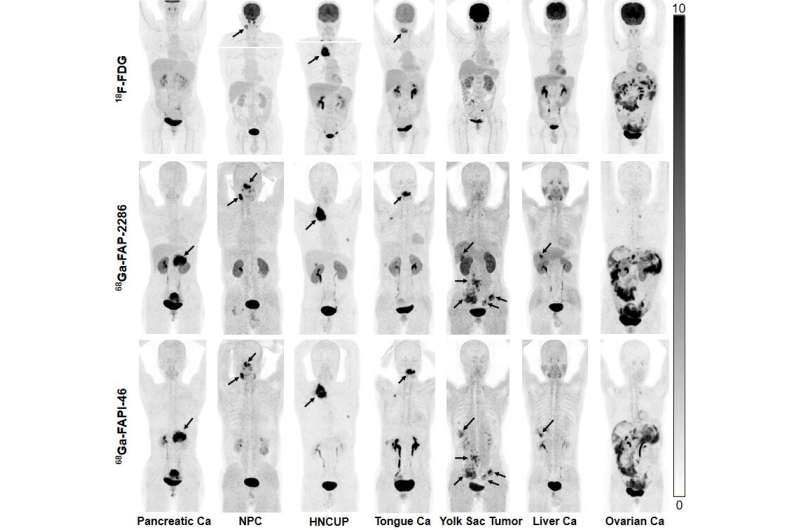This article has been reviewed according to Science X's editorial process and policies. Editors have highlighted the following attributes while ensuring the content's credibility:
fact-checked
peer-reviewed publication
proofread
Novel PET radiotracer successfully detects multiple cancers, offers potential for new targeted radionuclide therapy

A new radiotracer, 68Ga-FAP-2286, has been found to be more effective than the most commonly used nuclear medicine cancer imaging radiotracer, 18F-FDG. In a study published in the March issue of The Journal of Nuclear Medicine, 68Ga-FAP-2286 detected 100 percent of primary tumors across multiple cancer types as compared to 18F-FDG, which identified only 80 percent. 68Ga-FAP-2286 was also more effective in detecting lymph node metastases and distant metastases.
Currently, 18F-FDG, which measures glucose metabolism, is used extensively in nuclear medicine cancer imaging. Recent advances have shown that fibroblast activation protein (FAP), which is overexpressed in cancer cells, may be a better target for the imaging of solid tumors.
"In this study we aimed to investigate the diagnostic accuracy of 68Ga-FAP-2286—a radionuclide developed to target FAP—for detecting the primary and metastatic lesions in patients with various types of cancer," said Haojun Chen, MD, Ph.D., nuclear medicine physician at the First Affiliated Hospital of Xiamen University in Xiamen, China.
Sixty-four patients with 14 types of cancer were included in the study. Sixty-three of the patients underwent paired 68Ga-FAP-2286 and 18F-FDG PET/CT, and 19 patients underwent paired 68Ga-FAP-2286 and 68Ga-FAP-46 (another 68Ga-radiolabeled variant). Results were evaluated and compared.
68Ga-FAP-2286 PET yielded a higher radiotracer uptake, tumor-to-background ratio and tumor detectability than 18F-FDG. In addition, 68Ga-FAP-2286 and 68Ga-FAPI-46 yielded comparable clinical results.
"The novel radionuclide 68Ga-FAP-2286 is shown to be a promising FAP-inhibitor derivative for safe cancer diagnosis, staging and restaging," stated Chen. "Specifically, it may be a better alternative for diagnosing the cancer types that exhibit low-to-moderate uptake of 18F-FDG, such as head and neck, gastric, pancreatic and liver cancer."
Chen also noted that FAP-2286 not only exhibits promising characteristics for diagnosis, but also for cancer treatment. "Due to its molecular makeup, FAP-2286 can be paired with 177Lu to create a new radiopharmaceutical therapy," he said. "177Lu-FAP 2286 has the potential to offer potent and selective FAP binding, which could lead substantial therapeutic efficacy for cancer patients in the future."
More information: Yizhen Pang et al, PET imaging of fibroblast activation protein in various types of cancers by using 68Ga-FAP-2286: Comparison with 18F-FDG and 68Ga-FAPI-46 in a single-center, prospective study, Journal of Nuclear Medicine (2022). DOI: 10.2967/jnumed.122.264544



















